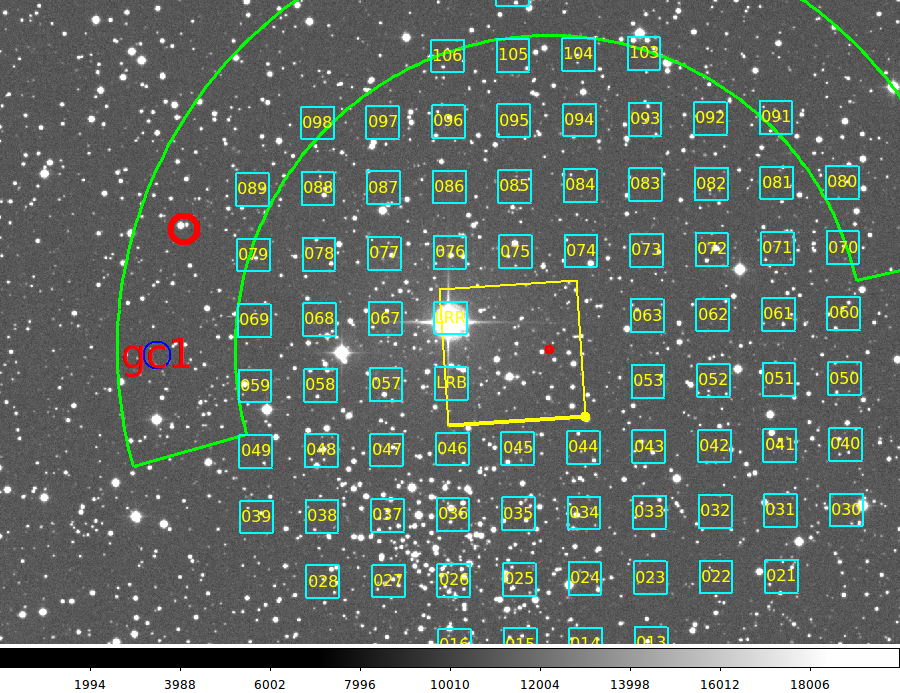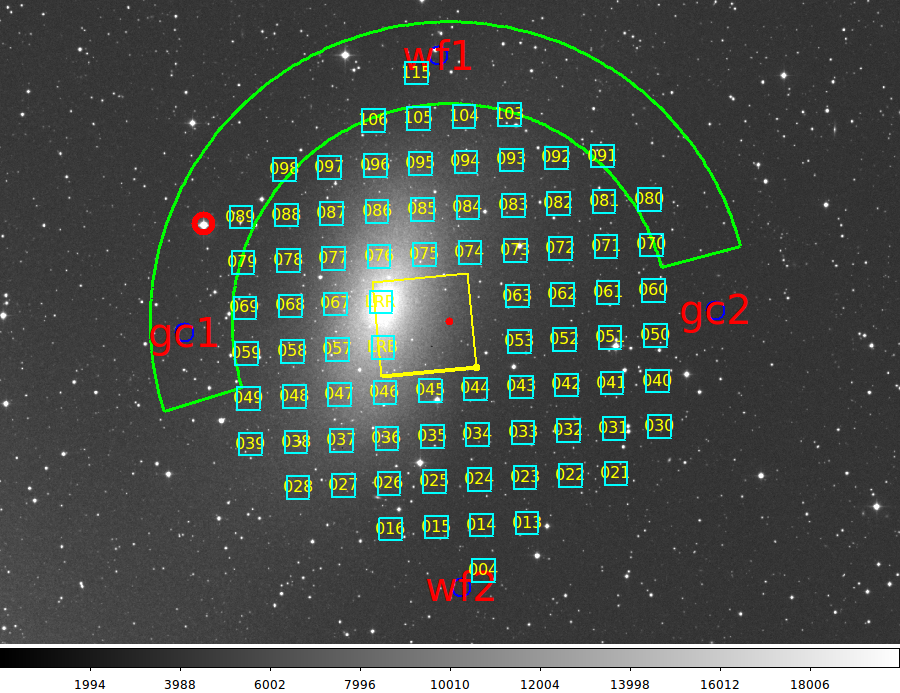 |
| A sample gstar image for setting up the LRS2 R channel onto a bright star. After the initial image is made, we are ready to select a guide star. |
Build a simulated ACAM image that has WCS in the FITS header for a given Ra,Dec,AZ of the HET.
% acam_fake 23:57:24.01 +61:07:35.8 336.0 178.0 391.0 Y Usage: acam_fake 23:57:24.01 +61:07:35.8 336.0 178.0 391.0 Y arg1 - RA (sexigecimal) arg2 - DEC (sexigecimal) arg3 - Azimuth of HET structure (degrees) arg4 - X_ihmp arg5 - Y_ihmp arg6 - Display with ds9 (Y/N) Note for ihmp: X,Y= 173 394; later X,Y= 178 391The results of this run would be the image (acam_dss.fits), the DSS image of the same field (dss.fits) and a USNO catalog of the area (STARS.cdfp) and the regions file for plotting these objects (STARS.cdfp.reg).
Sometimes, I might want to build the image, but then not have the automatic ds9 display stuff activated. I could turn the ds9 option off (arg6=N) and then display things manually with:
% acam_fake 23:57:23.97 +61:07:37.4 336.0 178 391 N % ds9_open 1000 1000 % xpaset -p ds9 file dss.fits % xpaset -p ds9 scale limits 0.0 20000.0 % wcs_outline acam_dss.fits dss.fits % xpaset -p ds9 zoom to fit % cat STARS.cdfp.reg | xpaset ds9 regions -format ds9
The acam field overlaps the LRS Red and Blue IFU slots.
From the Nov2015 run we measure ACAM positions for LRS2:
LRS2_RED 730 585
LRS2_BLUE 738 217
The IHMP position at that time was assumed to be: X=178 Y=391
Suppose I want to build an acam image for the case where I
place a target onto LRS2_RED (LRR). I will use our default
gstar example as a starting point:
% gstar 06:15:20.46 +39:51:50.6 304.0 gc1 There is a bright star that I want to go into LRS2_RED: Ra,Dec = 06:15:17.075 +39:56:45.60 The AZ would remain the same (304). So I would run: font color=black size=5> % acam_fake 06:15:17.075 +39:56:45.60 304.0 730.0 585.0 NThis would make my acam_dss.fits image, and the bright star would be located at X,Y=730,585. To set up on the image I need to know where to place the HET IHMP center, but I can find this with xy2sky and my acam_dss.fits image:
font color=black size=5> Assume IHMP X,Y = 178,391 % xy2sky acam_dss.fits 178 391 06:15:03.763 +39:56:06.63 J2000 178.000 391.000 This means I want to run gstar with: Ra,Dec = 06:15:03.763 +39:56:06.63 To be sure I use the proper X,Y_IHMP: % cat IHMP.Position 178.000 391.000 % gstar 06:15:03.763 +39:56:06.63 304.0 gc1
 |
| A sample gstar image for setting up the LRS2 R channel onto a bright star. After the initial image is made, we are ready to select a guide star. |
Here I describe a full example of observing a well known galaxy.
% rc3gal n205 Name_RC3 RA_2000DEC_2000 Type Input_name NGC 205 00:40:22.50 +41:41:11.0 .E.5.P. n205 dssget 10.093751 41.686390 10.0 dss poss1_red % skycal.sh 00:40:22.50 +41:41:11.0 now From the listing: Summary of SKYCAL data: Target RA,DEC : 00:40:22.50 +41:41:11.0 UT date : 20160210 UT : 23:43:34 LST : 02:09:27.19 Hour Angle : 01:29:04.69 (WEST) Target Altitude,Azimuth (degrees) : 69.011 307.804 Target airmass : 1.071 To get the AZ I would use with the HET: Usage: estimate_azhet_hetq 02:35:27.90 +39:39:52.0 63 arg1 - RA in sexigecimal format (hh:mm:ss.ss) arg2 - DEC in sexigecimal format (+dd:mm:ss.s) arg3 - approximate AZ % estimate_azhet_hetq 00:40:22.50 +41:41:11.0 307.8 300.070 274.68338 % cat estimate_azhet_hetq.explain AZ HET_PA AZ = HET structure azimuth HET_PA = HET parallactic angle To get the acam image: % acam_fake 00:40:22.50 +41:41:11.0 300.07 730.0 585.0 N % xy2sky acam_dss.fits 178 391 00:40:08.691 +41:40:38.97 J2000 178.000 391.000 % gstar 00:40:08.691 +41:40:38.97 300.07 gc1 For gc1 star, use x_ang,y_ang = 0.06513 -0.14562 Ra,Dec,Az(IHMP): 00:40:08.691 +41:40:38.97 300.07 Telecen_X, Telecen_Y, (Ra,Dec)_probe, Probe_name: 0.06513 -0.14562 00:40:57.867 +41:43:52.38 gc1 syscmd -T -v 'Guider1_set_position( x_ang=0.06513, y_ang=-0.14562) ' syscmd -T -v 'pfip_move_probes()' *** These Telecen_X,Y have tested as VALID
 |
| The gsatr result our effort to place the galaxy NGC205 onto LRS2 R. We use a simple run (rc3gal) to find the coordinates for this famous galaxy. We make the "fake" acam image in order to learn where our IHMP center must fall on the sky. We use a few little scripts to learn the azimuthn we'll observe at, and then we run gstar to verify that NGC205 will fall inthe correct IFU and to select a guide star for gc1. |
Hi Matt (and Gary):
I was thinking about our conversation last night on how to establish
the X,Y coordinates of points in the IHMP system (i.e. the x,y for 056,
066,555 etc in the fplane.txt file.) You said you were going to play
around with Steven's images used to establish the acam positions for
these things. These questions are critical for how we do blind setups,
so they are worth considering.
I'm prety sure we really have two problems at play here:
1) how to we predict x,y of targets in the simulated
acam image (whether by shufle or other codes)
2) How we predict where an ihmp position is on the acam
The job of #1 is performed (in shuffle, fake_acam, etc...) with
four numbers: the acam position of the ihmp center (in shuffle
these are acam_x_origin,acam_y_origin), the small change to the
general field rotation beyond that predicted by the parallactic
angle (in shuffle this is the variable named "acam"), and the
plate scale (not sure what this is called in shuffle, but we know
it is PS_acm = 0.2709 -+0.0002 arcsec/pixel).
**** I think these are the ONLY 4 numbers (3 really) that you
should adjut. Not any ihmp x,y values.
The point is that we need to be able, via those four numbers, make
any real X,Y of a target in the acm match the shuffle value. ANY
acm image with a suffient number of stars can be used for checking
this. I have 90 acm images (since Dec2017) that are well calibrated
(WCS with 0.2" to 0.4" rms) and a list of dates when ihmp or fpa
work was done. I'll be looking into how well we can predict the
(X,Y)_acm for all targets in the field. In other words: I'll use a
large number of acm images to determine the 4 shuffle parametrs.
The next part (#2) is a separate problem. How do we take X,Y_ihmp
(fplane.txt coordinates) and predict positions in the acm coordinate
frame. The bottom line is: we shoyld not be changing shuffle parameters
AND fplane.txt position with the same data sets.
The question is how we determine firm ihmp positions. With regard to
ihmp positions, I see a way forward with the LRS2-R,B. However, I'm
really wondering how the fplane.txt coordinates for BIB (555) were
established? This is why I am cc'ing Gary. Does anyone remember how
the values of X,Y_ihmp = 3.3 -73.2 were set for the BIB?
I think until we separate these 2 problems, we really don't know what
is happening in a blind offset setup. Sorry to go on here, but any words
about the BIB position (in ihmp) would be very helpful.
-Steve